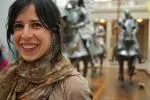
Mediated Congregation - Architecting The Crystal Cathedral
Erica Robles-Anderson, Department of Media, Culture, and Communication, New York University
Tuesday, April 24, 12:30 pm
Berkman Center, 23 Everett Street, Second Floor
Within the past thirty years the rise of a new style of worship, coined “megachurch”, has transformed the American religious landscape. Blending audio, visual, and communications technologies within postmodern architectures, megachurches radically re-imagine Christianity. These re-contextualizations of secular technologies carry particularly symbolic meaning; for believers, megachurches make visible God's hand at work in the conditions of 20th and 21st century mediated social life. They produce conditions for apprehending a Protestant ethic within the networked worldview.
This talk reads megachurches as part of late 20th century shift towards conducting collective life in increasingly mobile, mediated, and distributed arrangements. Based on a case study of a pioneering and particularly influential institution, the Crystal Cathedral (1955 - present), I trace a series of translations via automobiles and drive-in cinema (1955 - 1961), then glass, steel, and television (1962 - 1970), and finally architectural postmodernism , satellite television, and the Internet (1980 - present) by which a traditional narrative of mythic worldview entered a new technological regime.
About Erica
Erica Robles-Anderson is an Assistant Professor in the Department of Media, Culture, and Communication at New York University. Robles-Anderson's work focuses on forms of collective life in mediated material conditions. She is currently completing a manuscript on the 20th century transformation of Protestant worship through the adoption of new media technologies and contemporary architectural materials. Before her position at NYU Robles-Anderson held a joint appointment as a post-doctoral researcher at HumLab and in the Department of Culture and Media at Umeå University. She holds a Ph.D. in Communication and a B.S. in Symbolic Systems from Stanford University.